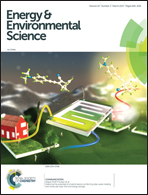3D-printed fluidic networks for high-power-density heat-managing miniaturized redox flow batteries†
Abstract
The miniaturization of redox flow cells (RFCs) paves the way to novel energy conversion concepts combining power delivery and heat regulation. Envisioning the integration of high-power-density RFCs into electronic devices such as microprocessors, lasers, or light-emitting diodes for the purpose of providing power and heat management simultaneously, we introduce and investigate interdigitated, tapered multiple-pass microfluidic networks in miniaturized flow cells. Employing 3D-printing for the facile and inexpensive fabrication of these networks, we demonstrate RFCs with maximum power densities of up to 1.4 W cm−2 at room temperature and net power densities of up to 0.99 W cm−2 after subtracting pumping power losses. The electrolytes employed modest concentrations of 0.4 M K4Fe(CN)6 and 0.2 M 2,6-dihydroxyanthraquinone in alkaline electrolyte. We thereby show that rational tailoring of fluidic networks in RFCs is key for the development of devices effectively combining power delivery and thermal management.



 Please wait while we load your content...
Please wait while we load your content...